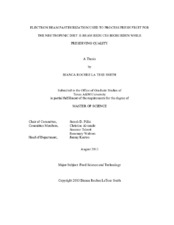| dc.contributor.advisor | Pillai, Suresh D | |
| dc.creator | Smith, Bianca R | |
| dc.date.accessioned | 2013-12-16T20:16:50Z | |
| dc.date.available | 2015-08-01T05:48:31Z | |
| dc.date.created | 2013-08 | |
| dc.date.issued | 2013-08-09 | |
| dc.date.submitted | August 2013 | |
| dc.identifier.uri | https://hdl.handle.net/1969.1/151381 | |
| dc.description.abstract | Fresh produce is often touted for its many health benefits; however, various items have been linked to foodborne disease outbreaks. This is especially a concern for immune suppressed individuals who are classified as severely neutropenic (white blood cell count under 500 neutrophils/μL of blood). At this degree of suppression, many are urged to follow a restrictive diet that reduces the potential of exposure to microbial populations. Currently no processing technique is used to sanitize microorganisms from fresh produce. Electron beam (e-beam) irradiation is a non-thermal process that has been approved by the FDA to treat fresh foods and is able to eliminate bacteria. Another technology used to extend shelf life is modified atmosphere packaging (MAP). The objective of this study was to evaluate the use of e-beam irradiation at current FDA-approved doses (< 1 kGy) to determine whether bioburden on fresh fruits can be reduced while maintaining sensory quality. Aerobic plate count methods were employed to determine the bioburden of treatments over a 21 day storage period under both ambient and MAP conditions. A previously identified bacterial plate count benchmark of < 500 CFU/ gram will be used to determine the applicability of the e-beam treatment. A consumer study using a 9 point hedonic scale as well as instrumentation measuring color, texture, moisture content, total soluble solids and titratable acidity were used to compare the treated fruit to the control. E-beam consistently reduced the bioburden on strawberries, fresh-cut watermelon and significantly (p<0.05) for avocado samples. Avocado, grapes and watermelon showed potential to be labeled as clean foods (below 500 CFU/gram). Fruit firmness (as measured by deformation) was not negatively affected by e-beam treatment and was preserved over storage with MAP treatment. Color was not adversely affected by e-beam or MAP, except for avocados that were significantly more grey in the presence of O_(2). Most importantly, consumers rated e-beam and MAP treated samples as acceptable (score above 5) in qualities of color, odor, flavor and firmness. E-beam proved to be an effective tool in reducing bioburden at low doses while maintaining fruit quality. | en |
| dc.format.mimetype | application/pdf | |
| dc.language.iso | en | |
| dc.subject | e-beam | en |
| dc.subject | modified atmosphere packaging | en |
| dc.subject | fruit | en |
| dc.subject | bioburden | en |
| dc.title | Electron Beam Pasteurization of Fresh Fruit for Neutropenic Diet: E-beam Reduces Bioburden While Preserving Quality | en |
| dc.type | Thesis | en |
| thesis.degree.department | Nutrition and Food Science | en |
| thesis.degree.discipline | Food Science and Technology | en |
| thesis.degree.grantor | Texas A & M University | en |
| thesis.degree.name | Master of Science | en |
| thesis.degree.level | Masters | en |
| dc.contributor.committeeMember | Alvarado, Christine | |
| dc.contributor.committeeMember | Talcott, Susanne | |
| dc.contributor.committeeMember | Walzem, Rosemary | |
| dc.type.material | text | en |
| dc.date.updated | 2013-12-16T20:16:51Z | |
| local.embargo.terms | 2015-08-01 | |


